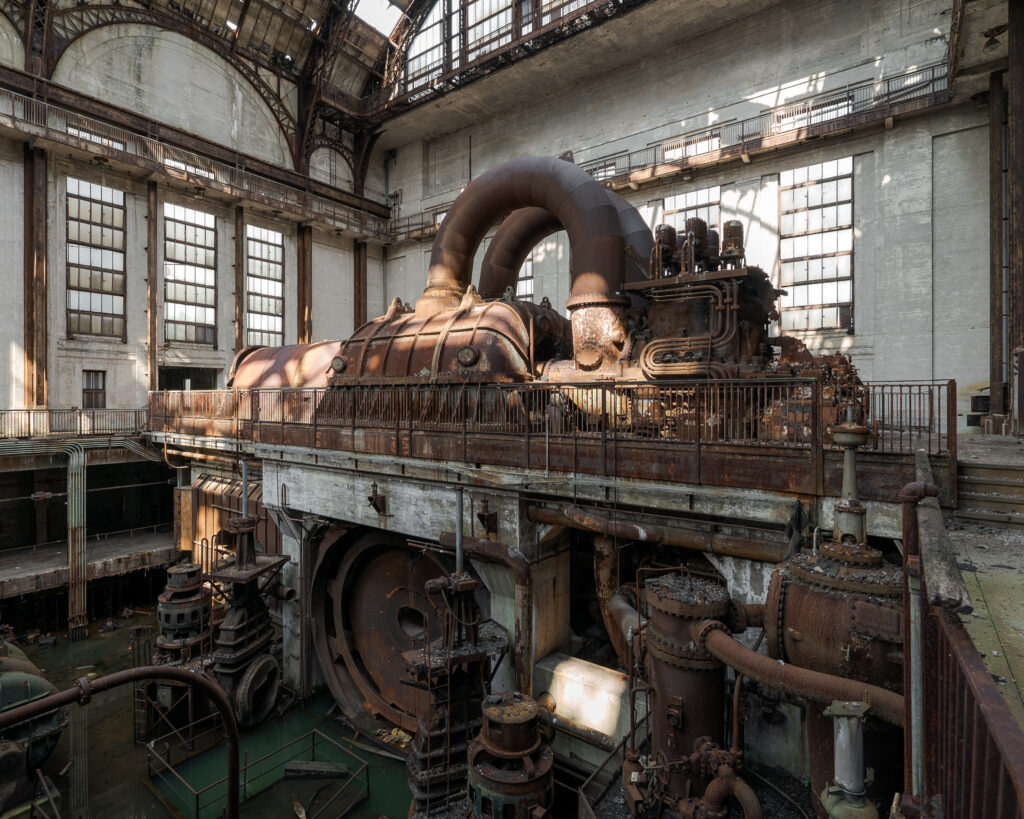
Power plants on the Delaware: Abandoned but still celebrated
| November 22, 2021
Behemoth buildings that once housed power plants and supplied electricity to Philadelphia dot the Delaware — remains from more than a century ago — that remind us of the history and development of the region.
Many of these former generating stations, some of which were built in the early 1900s and the 1910s by the Philadelphia Electric Company (PECO), have fallen into disrepair, left subjected to the elements and preyed upon by vandals and scrap metal thieves.
With their rusting hulks of turbines, pipes and valves and defunct control rooms with dials and buttons, the vibe of these places is that of a decaying, demented Willy Wonka Chocolate Factory (minus the sweet treats and Oompa Loompas).
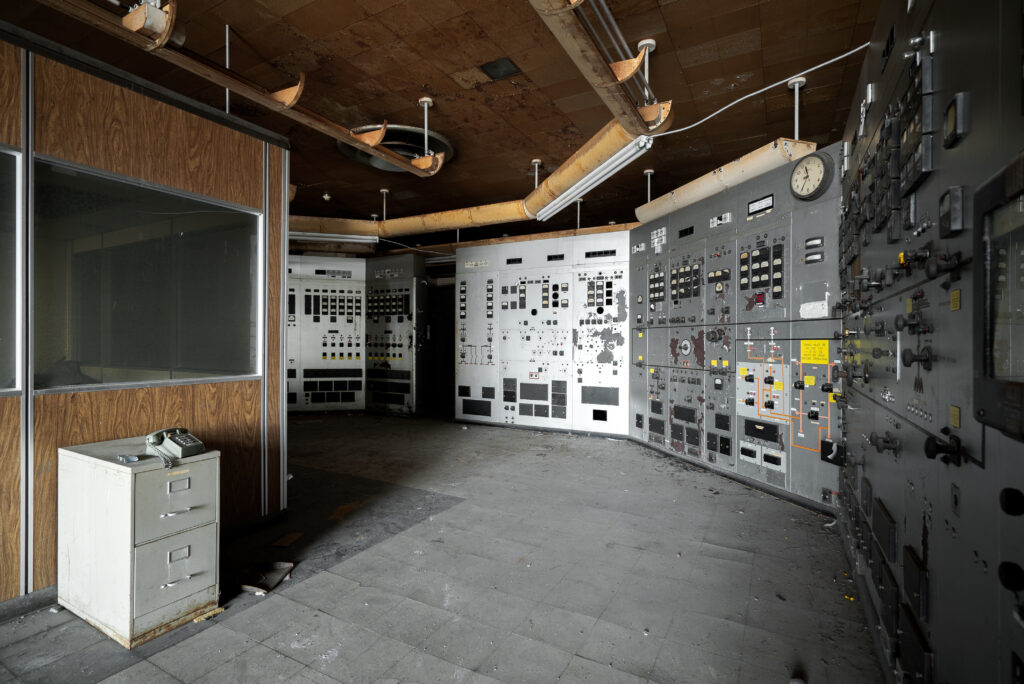
The control panels at the former Southwark Generating Station. The plant was built in the 1940s and was considered emblematic of post-war optimism. PHOTO CREDIT: The Proper People
Nonetheless, these abandoned properties are alluring to historic preservationists and urban explorers alike.
What’s the attraction?
“It’s the closest thing we have to Roman ruins,” said Aaron Wunsch, an associate professor in the graduate program in Historic Preservation and in the Department of Landscape Architecture at the University of Pennsylvania.
“First of all, they’re mysterious,” he added. “Second, they’re massive, and we just don’t have anything like them anymore.”
Buildings stood for “solidity and immensity”
What makes the former power plants on the Delaware unique is that they were built on or near a major city (in this case, Philadelphia) and during the Roaring Twenties, when companies were willing to invest in edifices that made a statement, said Michael Berindei, an urban explorer who has visited the sites.
The 1920s were a peak period of ornate buildings that signaled they’d be there forever as opposed to today when power plants are essentially warehouses of generators, he said.
Back then, they were considered art.
Electricity at the time was still new and some members of the public needed to be reassured it was safe. The buildings had a way of projecting that sense of confidence, he said.
To comprehend the sheer mass and scale of these plants, consider that one of these plants, the Southwark Generating Station, viewed through Google 3D, would take up two blocks in Philadelphia and would be half as tall as some of the city’s skyscrapers – even taller if you consider the smokestacks, Berindei said.
He said some of the plants are so mammoth that parts of them can actually have their own climates. It’s not unusual, for instance, to see clouds or haze forming in one section of the building versus another.
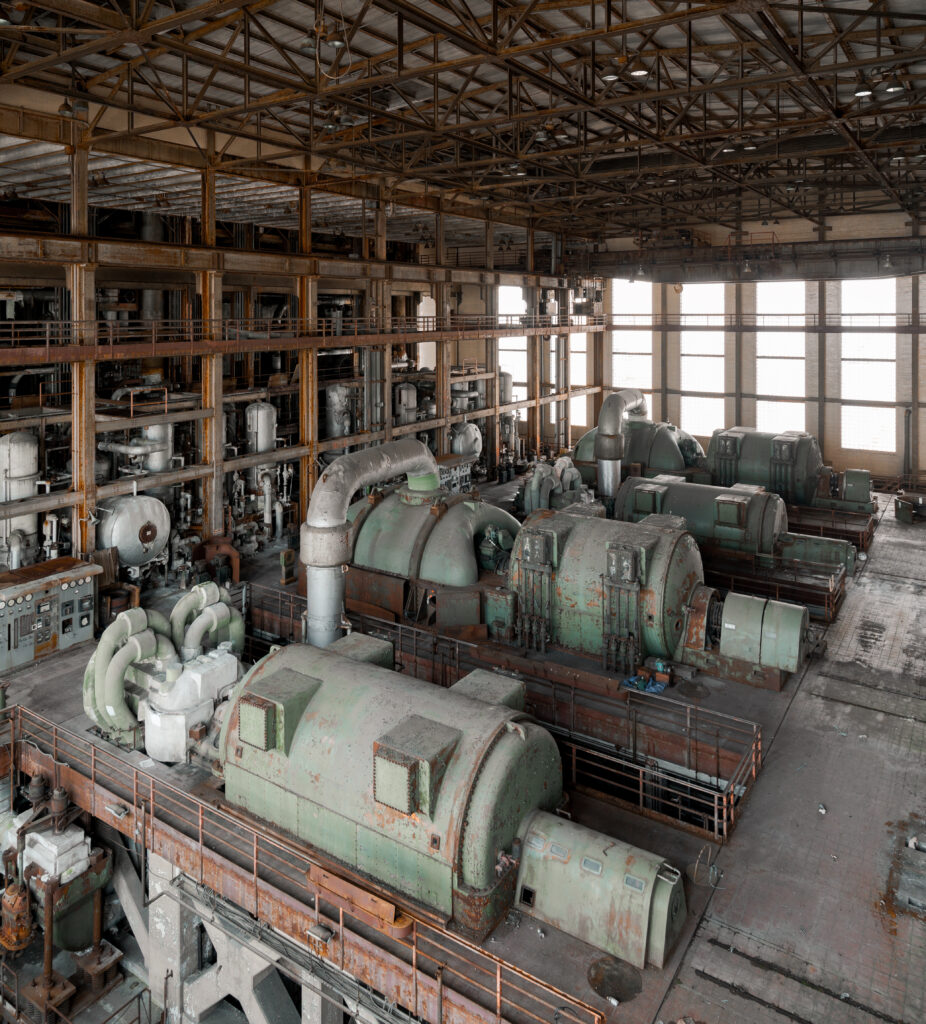
The future of the former Southwark Generating Station in Philadelphia is unclear. Vandals and scrap metal scavengers have gutted much of the interior. PHOTO CREDIT: The Proper People
Wunsch, who co-wrote the book “Palazzos of Power,” about Philadelphia power generating stations built by PECO from 1900 to 1930, started to explore the former plants as part of a master’s thesis in the 1990s.
He was drawn to them in part because, as he put it: “These are totally over the top. What’s going on here?”
The answer to that, in a historical context, is that the buildings were part of political and public relations campaigns waged by the power company.
At the time that some of these coal-fired plants were built, PECO was trying to beat back criticism that it had underfunded its infrastructure and was overcharging its ratepayers.
It was also at a time when there was a tug of war over whether utilities such as PECO should be privately or publicly controlled, Wunsch said.
The buildings stood for strength and permanence, a signal to its customers and regulators that the power company was reliable and dependable. PECO so embraced this concept that in the captions of its drawings for the plants were the words “solidity and immensity,” Wunsch said.
How that philosophy evolved over time can be seen in the differences from the company’s first plant, the Schuylkill Generating Station, which was built in 1903 and was essentially an “arched brick box” compared with the strong “Neo-Roman colossus” of generating stations built along the Delaware more than a decade later, he said.
Comparisons to the old Penn Station
Consider, for instance, the Port Richmond Generating Station, which was built in 1925 and was shut in 1984. Industry publications once described it as “The Most Handsome Station in America.”
A University of Pennsylvania historic preservation report about potential uses of the site said the plant “merged the aesthetic and cultural power of beaux-arts design with latest technology to generate power to run the industries that earned Philadelphia the title of ‘The Workshop of the World.’”
The plant was designed by the PECO engineer W.C.L. Eglin and the architect John Torrey Windrim, the report said, adding that “its monumentality and classical aesthetics intentionally associate technological innovation with notions of permanence and tradition.”
Wunsch described the Port Richmond station as “spectacular,” and with its vaults and capacity for letting in huge amounts of natural light, closest in look and feel to the Penn Station of old in New York City.
Among the reasons these plants were built on the Delaware: Coal could be brought by barge and the river water used for condensing and cooling the huge turbines.
While Wunsch lauded these architectural marvels, he said the environmental damage they caused cannot be overlooked. PECO disposed of toxic coal ash loaded with poisons such as mercury that filled entire islands in the Delaware, he said.
Dangerous places to visit
Berindei said he’s visited about 50 abandoned power plants around the world and they’ve become his favorite places to explore.
Berindei, with his fellow urban explorer Bryan Weissman, are known as The Proper People, a nod to a sign posted at a property they once visited that declared “Access Prohibited Except by the Proper People.”
They visited the Port Richmond generating station in Philadelphia, which has been used for scenes in movies such as “Transformers 2,” “The Last Airbender” and “12 Monkeys.”
The video of their visit shows them treading carefully throughout the plant. They note – in more than a bit of understatement – that “this place is extremely dangerous” after the camera zooms in on a concrete chunk of ceiling dangling precariously high above them.
At another point, as they walk over some rusted grates, they joke, “These grates are not great.”
The power plants were built to echo the sense of strength and gravitas of the monuments in Washington, D.C., Berindei said. As such, many power stations in their day offered public tours or even had observation areas where visitors could watch the inner workings.
Berindei said he relies on old trade journals and advertisements of the time to put these buildings in their proper time and place. “Once you’ve experienced a place like this, it’s begging to be contextualized,” he said.
Weissman and Berindei also visited the Southwark Generating Station, which they called a “lesser-known gem” in a videotaped visit.
They described the Southwark plant as an “icon of progress” and as a “landmark structure that was the beating heart of a city.” Southwark, which was built in the 1940s, was emblematic of post-war optimism and a “monument of its time,” they said.
A video of the site shows painting peeling from a door in such a way as to resemble a warped world map.
Beyond the large-scale industrial machinery, the video hints at the humans who once populated Southwark: Footage shows a daily calendar book from 1977 and a jar of Coffee Mate still on a shelf in an employee break room.
Some power plants find a new life
Not all of the plants have been gutted and abandoned. There have been creative ideas for adaptive re-uses.
The Chester Waterside Station in Chester in Delaware County, Pa., which was completed in 1919 and was finally shut down in 1987, was remediated and redeveloped into office space. And permits for the redevelopment of another former power plant, the Delaware Generating Station, into housing units have been issued, the website Philadelphia YIMBY reported in January.
The Schuylkill station, which became an oil-burning plant owned by the power company Exelon, was retired at the end of 2012, The Philadelphia Inquirer reported.
It’s unclear what the future might hold for the Port Richmond and Southwark sites. Exelon, which now owns those sites, did not respond to a request for comment.
During their visits, Weissman and Berindei have faced an array of environmental hazards, such as exposure to PCBs, lead paint and mercury, mold, asbestos and pigeon droppings.
Why risk their health like that?
Berindei said that, after doing urban exploring for seven years, he’s concluded that it’s a chance to bear witness and document places that would otherwise be lost to destruction.
During the pandemic, there has been a worldwide “slaughter” of abandoned industrial sites because scrap metal prices have skyrocketed, leading to scavenging and gutting, Berindei said.
He added that visiting sites like those on the Delaware gives rise to a “solemn sense” that “we’re never going to build something like this again because the world is so disposable because of the bottom line.”



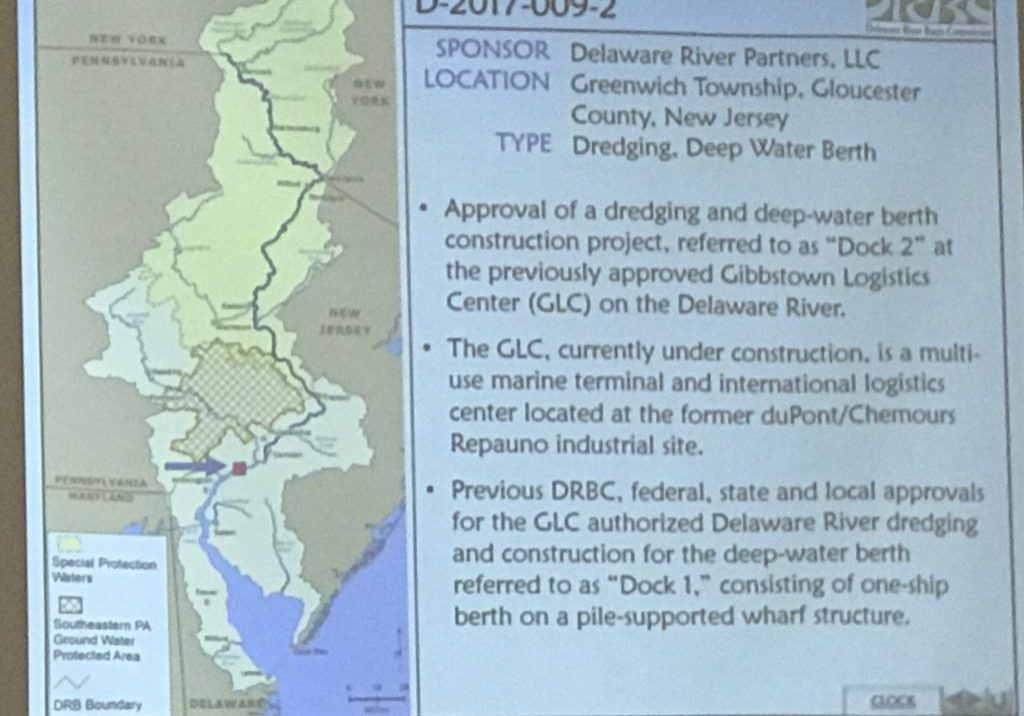

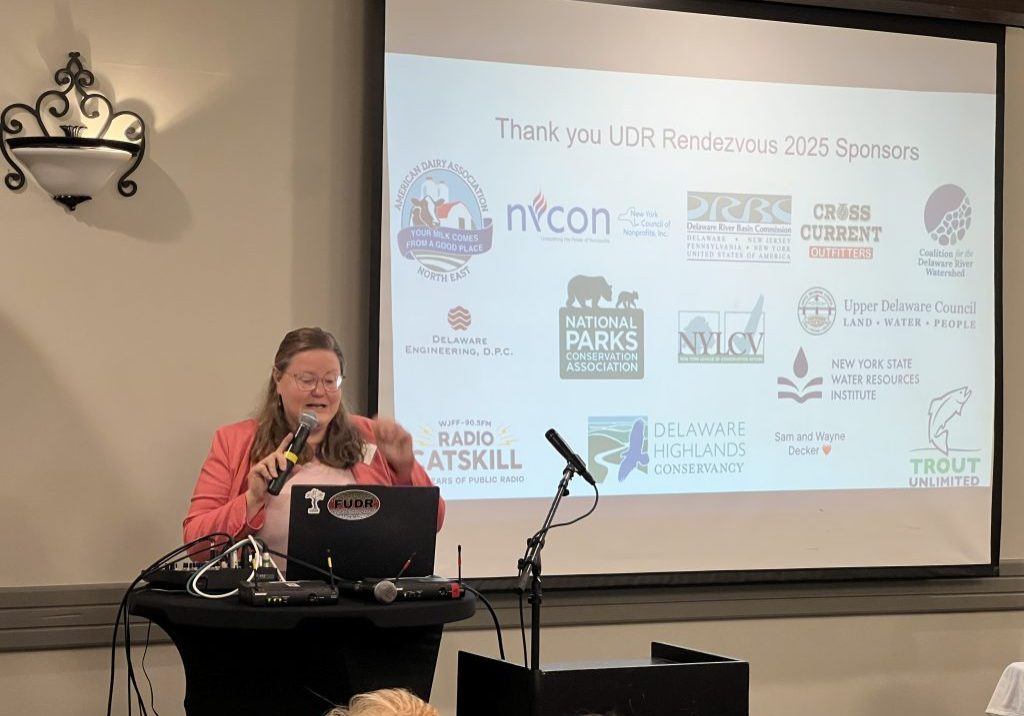
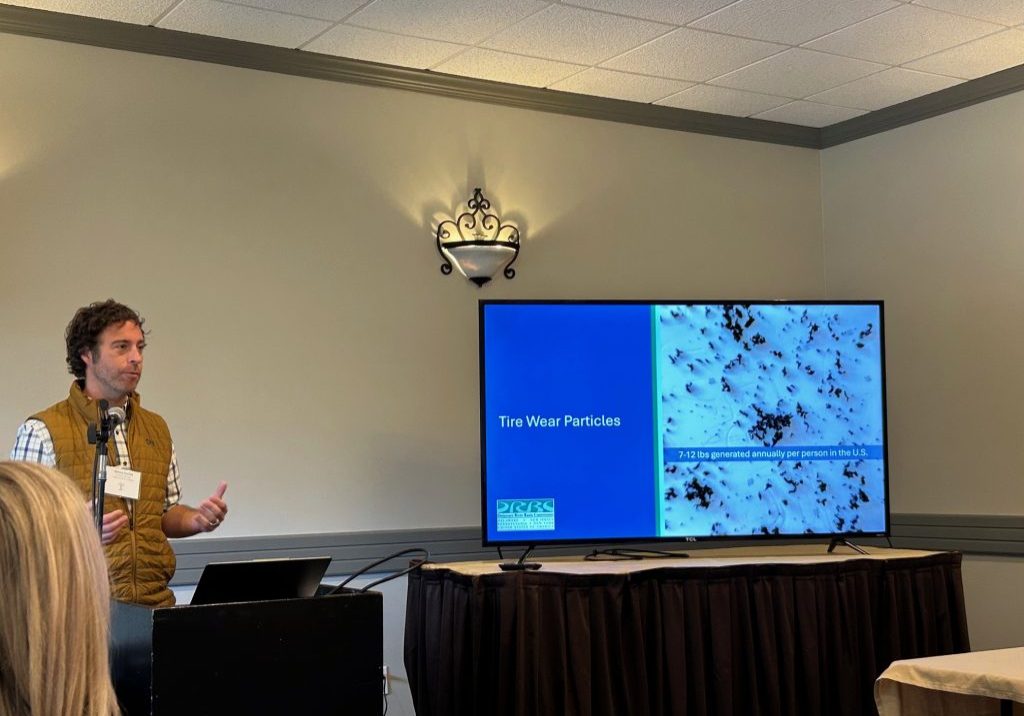
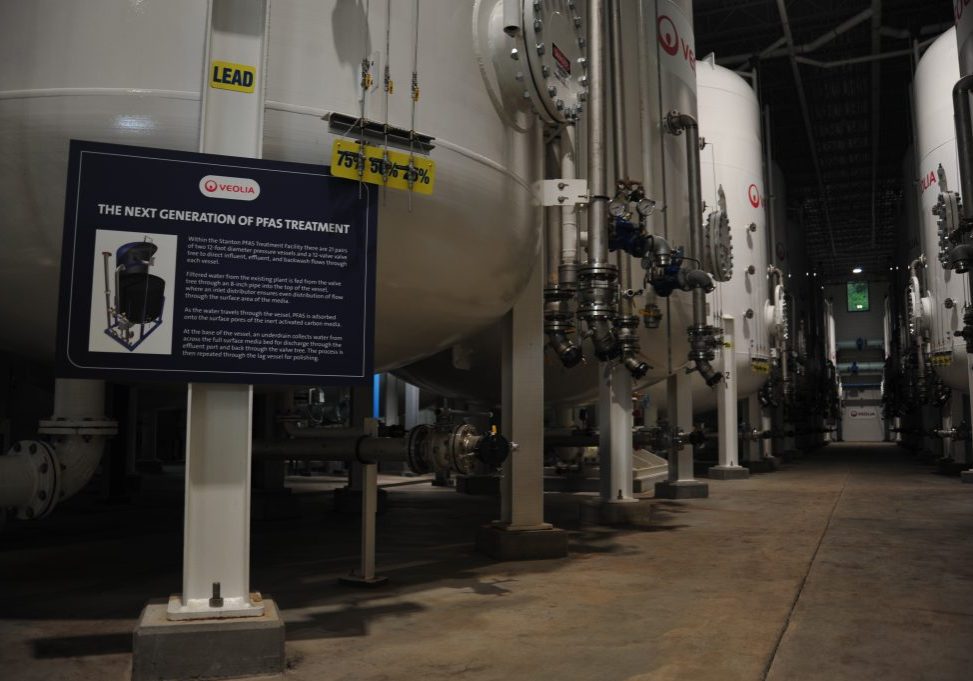
Thank you for this report on Urban Archaeology and ‘the proper people’ and their work in preserving our real technological heritage. Long taken for granted, denounced by so-called ‘environmentalists’, it’s easy to forget that life sans electricity is not a Soho picnic.
Paul Vincent Zecchino
Manasota Key, Florida
28 November, 2024
Fascinating article and great photos. I would love to be able to tour these buildings. Do you know about the Society for Industrial Archeology? They might be interested in this article. https://www.sia-web.org/